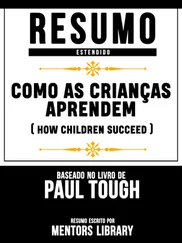Stress physiologists have found a biological explanation for this phenomenon as well. The part of the brain most affected by early stress is the prefrontal cortex, which is critical in self-regulatory activities of all kinds, both emotional and cognitive. As a result, children who grow up in stressful environments generally find it harder to concentrate, harder to sit still, harder to rebound from disappointments, and harder to follow directions. And that has a direct effect on their performance in school. When you’re overwhelmed by uncontrollable impulses and distracted by negative feelings, it’s hard to learn the alphabet. And in fact, when kindergarten teachers are surveyed about their students, they say that the biggest problem they face is not children who don’t know their letters and numbers; it is kids who don’t know how to manage their tempers or calm themselves down after a provocation. In one national survey, 46 percent of kindergarten teachers said that at least half the kids in their class had problems following directions. In another study, Head Start teachers reported that more than a quarter of their students exhibited serious self-control-related negative behaviors, such as kicking or threatening other students, at least once a week.
Some of the effects of stress on the prefrontal cortex can best be categorized as emotional, or psychological: anxiety and depression of all kinds. I kept in touch with Monisha in the months after our first meeting, and I saw a lot of those emotional symptoms in her. She was plagued by self-doubt—about her weight, her parenting ability, her prospects in general. She was assaulted one night by an ex-boyfriend, a sketchy character she had invited over, against her better judgment, to stave off her loneliness. And she struggled constantly to cope with a flood of emotions that always seemed on the verge of capsizing her. “Sometimes the stress is just too much for me to bear,” she told me one day. “I don’t see how people deal with it.”
For Monisha, the main effect of stress overload on her prefrontal cortex was that she had a hard time regulating her emotions. For many other young people, though, the main effect of stress is that it compromises their ability to regulate their thoughts. This has to do with a particular set of cognitive skills located in the prefrontal cortex known as executive functions. In wealthy school districts, executive function has become the new educational catch phrase, the most recent thing to evaluate and diagnose. But among scientists who study children in poverty, executive functions are a newly attractive field for another reason: improving executive function seems like a potentially promising vehicle for narrowing the achievement gap between poor kids and middle-class kids.
Executive functions, as we now understand them, are a collection of higher-order mental abilities; Jack Shonkoff, the head of the Center on the Developing Child at Harvard University, has compared them to a team of air traffic controllers overseeing the functions of the brain. Most broadly, they refer to the ability to deal with confusing and unpredictable situations and information. One famous test of executive-function ability is called the Stroop test. You see the word red written in green letters, and someone asks you what color that word is. It takes some effort to stop yourself from saying red, and the skills you’re drawing on when you resist that impulse are executive functions. And those skills are especially valuable in school. We’re constantly asking kids to deal with contradictory information. The letter C is pronounced like a K —unless it is pronounced like an S. Tale and tail sound the same but have different meanings. A zero means one thing on its own and an entirely different thing with a one in front of it. Keeping track of those various tricks and exceptions requires a certain amount of cognitive impulse control, and that is a skill that is neurologically related to emotional impulse control—your ability to refrain from punching the kid who just grabbed your favorite toy car. In both the Stroop test and the toy-car incident, you’re using the prefrontal cortex to overcome your immediate and instinctive reaction. And whether you’re utilizing your self-control in the emotional realm or the cognitive realm, that ability is crucially important to getting through the school day, whether you’re in kindergarten or your senior year of high school.
For a while now, we’ve known that executive-function ability correlates strongly with family income, but until recently, we didn’t know why. Then in 2009, two researchers at Cornell University, Gary Evans and Michelle Schamberg, designed an experiment that for the first time gave us a clear look at exactly how childhood poverty affects executive function. The particular executive-function skill they examined was working memory, which refers to the ability to keep a bunch of facts in your head at the same time. It’s quite distinct from long-term memory—working memory is not about remembering the name of your first-grade teacher; it’s about remembering everything you’re supposed to pick up at the supermarket. The tool that Evans and Schamberg selected to measure working memory was a kitschy one: the electronic children’s game Simon. If you grew up in the 1970s, as I did, you might remember this Hasbro game: it’s a UFO-looking disk about the size of an LP record but fatter, with four panels that light up and make distinct sounds. The panels illuminate in various sequential patterns, and you have to remember the order of the beeps and the flashes.
Evans and Schamberg used Simon to test the working memory of 195 seventeen-year-olds in rural upstate New York, all part of a group that Evans had been studying since they were born. About half the children had grown up below the poverty line and the other half in working- and middle-class families. Evans and Schamberg’s first discovery was that the amount of time that children spent in poverty when they were growing up predicted how well they would do on the Simon test, on average—kids who had spent ten years in poverty, in other words, did worse than kids who had spent just five years in poverty. This, on its own, was not too surprising; researchers had previously found correlations between poverty and working memory.
But then Evans and Schamberg did something new: They introduced some biological measures of stress. When the children in the study were nine years old, and again when they were thirteen, Evans’s researchers took a number of physiological readings from each child, including blood pressure, body mass index, and levels of certain stress hormones, including cortisol. Evans and Schamberg combined those biological data to create their own measure of allostatic load: the physical effects of having an overtaxed stress-response system. When they sat down with all the data and compared each child’s Simon score, poverty history, and allostatic-load reading, they found that the three measures correlated—more time in poverty meant higher allostatic-load numbers and lower scores on Simon. But then came the surprise: When they used statistical techniques to factor out the effect of allostatic load, the poverty effect disappeared completely. It wasn’t poverty itself that was compromising the executive-function abilities of the poor kids. It was the stress that went along with it.
This was, potentially at least, a big deal in terms of our understanding of poverty. Picture two boys sitting together playing Simon for the first time. One is from an upper-middle-class home, and one is from a low-income home. The kid from the upper-middle-class home is doing a lot better at memorizing the patterns. We might be inclined to assume that the reason for this effect is genetic—maybe there’s a Simon gene that rich kids are more likely to possess. Or maybe it has to do with material advantages in the upper-middle-class kid’s home—more books, more games, more electronic toys. Or maybe his school is a better place to learn short-term memory skills. Or perhaps it’s some combination of the three. But what Evans and Schamberg found is that the more significant disadvantage the low-income boy faces is in fact his elevated allostatic load. And if another low-income boy came along with low levels of allostatic load—if, for whatever reason, he had had a less stressful childhood, despite his family’s poverty—he would in all probability do just as well at the Simon competition as the rich kid. And why does a low Simon score matter? Because in high school, college, and the workplace, life is filled with tasks where working memory is crucial to success.
Читать дальше



![Коринн МакКей - How to Succeed as a Freelance Translator [calibre 3.46.0]](/books/402693/korinn-makkej-how-to-succeed-as-a-freelance-transl-thumb.webp)








